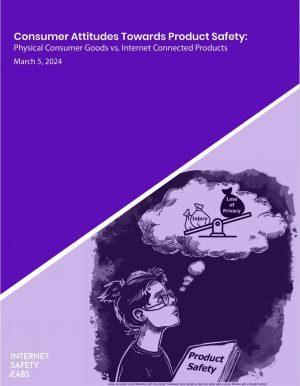
Just published: “Consumer Attitudes Towards Product Safety: Physical Consumer Goods vs. Internet Connected Products”. In my latest research with Lisa LeVasseur at Internet Safety Labs. we looked consumer perceptions and attitudes of safety of a variety of products. This research received financial support from the Internet Society Foundation.
…and if the 75 min read warning on LinkedIn scares you (it’s mostly charts anyway) jump to the intro and discussion to see what you really should be concerned about as digital makers. This is important information that every product designer and engineer should know.
Some interesting findings about product safety attitudes:
* When it comes to product safety, there’s a double standard among consumers for connected vs. unconnected products.
People expect product makers to be responsible for the safety of things like home goods, cars, cleaning products and the like. But they don’t have the same expectation when it comes to websites, Smart TVS and mobile apps.
* Many consumers appear unaware of the causal connection between personal and societal harms such as physical, emotional, reputational, and financial damage and the systemic loss of privacy tied to connected products and services.
Product consumers are subjecting themselves to more harms than they think when they trust digital product makers to take proper care of their personal information.
* Even though survey respondents didn’t score mobile apps as the “least safe” option—websites, smart automobiles and smart homes got that dubious honor—consumers expressed more concern about the safety of apps than the safety of other internet-connected products.
If you find that last point interesting, you will find Internet Safety Lab’s AppMicroscope educating. App Microscope displays Safety Labels for mobile applications. Currently, App Microscope contains over 1700 apps studied in the ISL 2022 K-12 EdTech safety benchmark.
Read the full report at Internet Safety Labs:
Consumer Attitudes Towards Product Safety: Consumer Products vs Internet-Connected Products:
Look for other reports in a summary of my work for Internet Safety Labs.
